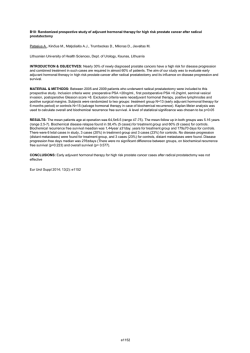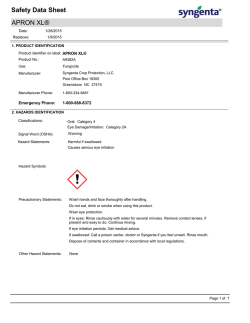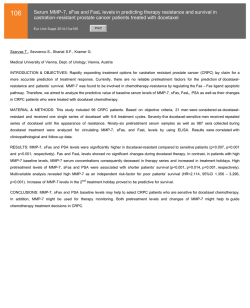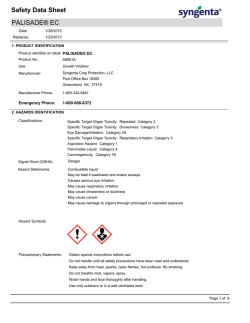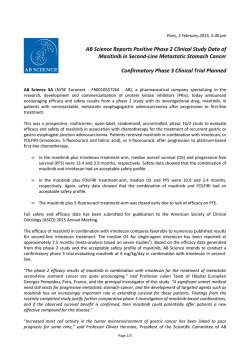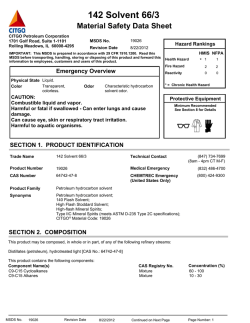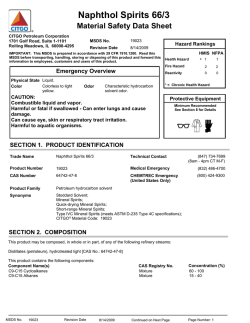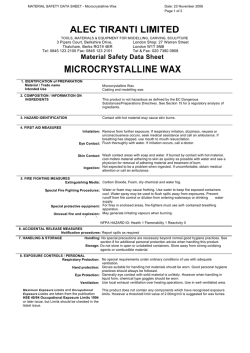
Oslo seminar 29 January 2015: Competing risks
Oslo seminar 29 January 2015: Competing risks Overview of lecture • Survival data: censoring, examples • Competing risks: cause-specific hazards and cumulative incidences (“rates and risks”) • European bone marrow transplantation data • Regression models Reference: Andersen, P.K., Geskus, R.B., de Witte, T., Putter, H. (2012). Competing risks in epidemiology: Possibilities and pitfalls. Int. J. Epidemiol. 41, 861-870. Per Kragh Andersen Section of Biostatistics, Department of Public Health University of Copenhagen, Denmark 1 Survival data Survival data are collected “in real time” and a study may be terminated before the event has occurred to all patients. Therefore, the observation times for those patients who are not observed to die are incomplete: right censoring 2 1. The PBC-3 trial in liver cirrhosis • Multi-centre randomized trial in patients with primary biliary cirrhosis. • Patients (n = 349) recruited 1 Jan, 1983 - 1 Jan, 1987 from six European hospitals and randomized to CyA (176) or placebo (173). • Followed until death or liver transplantation (no longer than 31 Dec, 1989); CyA: 30 died, 14 were transplanted; placebo: 31 died, 15 were transplanted; 4 patients were lost to follow-up before 1989. • Primary outcome variable: time to death, incompletely observed (right-censoring), due to: liver transplantation, loss to follow-up, alive 31 Dec, 1989 • In some analyses, the outcome is defined as “time to failure of medical treatment”, i.e. to the composite end-point of either death or liver transplantation 3 2. Survival with malignant melanoma • 205 patients with malignant melanoma (skin cancer) were operated at Odense University Hospital between 1962 and 1977 • All patients had radical operation, i.e. no treatment variable relevant here. Purpose: study prognostic factors • By the end of 1977: 57 had died from the disease, 14 had died from other causes, and 134 were still alive • Primary outcome variable: survival time from operation, but also mortality from disease is of interest • Primary outcome variable again incompletely observed due to end of follow up (and death from other causes) 4 3. European bone marrow transplantation data • Data from the European group for Blood and Marrow Transplantation (EBMT) • All (3982) chronic myeloid leukemia (CML) patients with an allogeneic stem cell transplantation from an HLA-identical sibling or a matched unrelated donor during the years 1997–2000. • Study effect of EBMT risk score with values 0–7, here grouped into five groups: 0, 1 (n = 506), 2 (n = 1159), 3 (n = 1218), 4 (n = 745), and 5, 6, 7 (n = 354). • Failure from transplantation may either be due to relapse or to non-relapse mortality (NRM). Often these two endpoints are taken together to relapse-free survival (RFS), which is the time from transplantation to either relapse or death, whichever comes first. 5 Methods for survival analysis Because of the incompleteness caused by censoring, we cannot use simple averages etc. for descriptive statistics and inference for survival data. Which parameters then to study for the distribution of the survival times, T in the target population? • E(T ), mean survival time. In principle possible, but difficult because the mean survival time depends heavily on the “tail” of the distribution (i.e., large values) for which the censoring leaves little information • S(t) = P (T > t), the survival function and the equivalent failure probability F (t) = 1 − S(t) = P (T ≤ t); F (t) is the risk of failure before time t • h(t), the hazard function with the interpretation (for small d > 0) h(t) ≈ P (die before t + d | alive t)/d, that is, the hazard function h(t) is the failure rate at time t. 6 Target population; censoring We wish to estimate such parameters (e.g., S(t) or h(t)) based on the censored data. These parameters refer to the potentially, completely observed target population. For this to be feasible: 1. The complete population (i.e., without censoring) should be well-defined 2. Censoring should not leave us with a biased sample Requirement 1 basically tells that the event under study should happen for every one in the population, e.g. composite end-point (Example 1), overall mortality (Example 2) or RFS (Example 3) but not transplantation (Ex. 1), death from disease, only (Ex. 2) or relapse (Ex. 3). 7 Independent censoring Requirement 2 is the assumption of independent censoring (by some denoted non-informative censoring). This means that individuals censored at any given time t should not be a biased sample of those who are at risk at time t. Stated in other words: the hazard h(t) gives the event rate at time t, i.e. the failure rate given that the subject is still alive (T > t). Independent censoring then means that the extra information that the subject is not only alive, but also uncensored at time t does not change the failure rate. 8 Typically, independent censoring cannot be tested from the available data - it is a matter of discussion. Censoring caused by being alive at the end of study can usually safely be taken to be “independent”. However, one should be more suspicious to other kinds of loss to follow-up before end of study. It is strongly advisable always to keep track of subjects who are lost to follow-up and to note the reasons for loss to follow-up (e.g., drop-out of follow-up schedule or emigration). 9 Possible questions in relation to examples. 1. What is the risk of having a liver transplantation for a CyA treated PBC patient with bilirubin 100 µmol/L? 2. Which fraction of the melanoma patients has died from the disease before 3 years from operation? 3. How is the risk of relapse related to the EBMT score? Easy solution: Use standard methods for analysis of survival data on the event of interest and censor for other events (and of course for end of follow-up etc.) However, this simple approach may be incorrect. 10 Recall: target population; censoring We wish to estimate parameters like F (t) or h(t) based on the censored data. These parameters refer to the potentially, completely observed target population. Recall that, for this to be feasible: 1. The complete population (i.e., without censoring) should be well-defined 2. Censoring should not leave us with a biased sample In the examples, requirement 2 is still an issue to be debated, however, requirement 1 will be violated when we censor for: 1. death without liver transplantation, 2. death from other causes, 3. death in remission. 11 This is because we attempt to make inference for a potentially completely observed population where these competing events do not occur. Such a population is quite hypothetical and it is unclear whether data from “this world” tell us much about that hypothetical population. We need methods to account for competing risks. 12 Two-state model for survival data 0 1 h(t) Alive ✲ Dead Transition intensity; hazard function (“rate”): h(t) ≈ P (state 1 time t + d | state 0 time t)/d. State occupation probabilities: survival function, S(t) = P (state 0 time t), and cumulative probability (“risk”) of death before time t: t F (t) = 1 − S(t) = P (state 1 time t) = 1 − exp(− 0 h(u)du). 13 Competing risks model 1 ✑Dead, cause 1 ✸ ✑ h1 (t) ✑ ✑ ✑ 0 ✑ ♣ ♣ ♣ Alive ◗ ◗ ◗ ◗ hk (t) ◗ k ◗Dead, cause k s 14 In the competing risks model (2 causes of death) Cause-specific hazards j = 1, 2 (“transition intensities”, “rates”): hj (t) ≈ P (state j time t + d | state 0 time t)/d. State occupation probabilities include the overall survival function: S(t) = P (alive time t) = exp(− t (h1 (u) 0 + h2 (u))du) = exp(−(H1 (t) + H2 (t)). and the cumulative incidences (“risks”) j = 1, 2: Fj (t) = P (dead from cause j before time t) = t 0 t t u u + du t ✲ t 15 time t 0 S(u)hj (u)du Rates and risks Note that the risk for cause 1 depends on the rates for both causes 1 and 2. For the two-state model for (overall) survival, hazard function h and failure function F contain equivalent information and one may be obtained from the other. This one-to-one correspondence is lost in the competing risks model: Both of the cause-specific hazards, h1 , h2 , are needed when computing each of the cumulative incidences, F1 , F2 . This is the key to understanding competing risks! 16 Rates and risks: technical note The same holds “the other way around”: both cumulative incidences are needed to compute a single cause-specific hazard. The relation is: t Hj (t) = 0 t = 0 dFj (t) S(t) dFj (t) . 1 − F1 (t) − F2 (t) 17 The Nelson-Aalen estimator with competing risks The cumulative cause-specific hazard can be estimated using the Nelson-Aalen estimator using only failures from the relevant cause, e.g., cause 1: H1 (t) = t 0 h1 (u)du may be estimated by H1 (t) = d(tj )I(cause=1) . tj ≤t R(tj ) This is an increasing step function with steps at each observed time of failure from cause 1. Interpretation of cumulative hazard? The cause-specific hazard itself is seen as the approximate “local slope” of the Nelson-Aalen estimator. 18 Non-parametric estimation of probabilities The overall survival function S(t) can be estimated by the Kaplan-Meier estimator, S(t), using all failures. The cumulative incidences: F1 (t) and F2 (t) may be estimated by plugging-in estimates for S(t), H1 (t) and H2 (t). E.g., for cause 1: d(t )I(cause=1) F1 (t) = tj ≤t S(tj−1 ) j R(tj ) (similarly for cause 2). This is often denoted the Aalen-Johansen estimator. Confidence limits may be calculated. 19 Using the Kaplan-Meier estimator on a single cause We have the relation: F1 (t) = P (dead from cause 1 before time t) = t 0 S(u)h1 (u)du. When h2 (t) = 0 (the competing event is not present) this is: 1 − exp(− t 0 h1 (u)du) = F10 (t) = 1 − S1 (t), say. That is, “1-Kaplan-Meier for cause 1”, 1 − S1 (t), estimates P(Dead from cause 1 before t) IF h2 (t) = 0! That is, if the competing risk does not exist. This hypothetical probability is rarely of interest. However, it is used frequently anyhow! E.g., “Relapse survival curve” in clinical cancer studies and “1-Kaplan-Meier” as risk estimator in epidemiological (and other) studies. 20 1-Kaplan-Meier vs. Aalen-Johansen We always have: F1 (t) ≤ F10 (t) = 1 − S1 (t), i.e. the cause 1 risk is over-estimated by using 1-Kaplan-Meier instead of Aalen-Johansen. The degree of bias depends on the magnitude of the competing risk (cause 2): if there are no competing risks (h2 (t) = 0) then they are identical, and the difference between the two increases with h2 (t). At best, the simple 1-Kaplan-Meier estimator can be considered an approximation to the cumulative incidence that may be used if the competing risk is small. 21 ‘Independent’ competing risks An alternative approach to competing risks is via latent failure times: L1 = time to failure from cause 1 , L2 = time to failure from cause 2, with joint survival distribution: Q(t1 , t2 ) = P (L1 > t1 , L2 > t2 ). Risks are then ‘independent’ if Q(t1 , t2 ) = S1 (t1 )S2 (t2 ). Observations are (with possible right-censoring): T = min(L1 , L2 ), D =corresponding cause. From these observations, neither the joint distribution Q(·, ·), nor the marginals are identifiable; only the cause-specific hazards (and functions thereof). So, ‘independence’ cannot be ascertained from the observed data and inference relying on the assumption is highly dubious (and not needed!) 22 Summary table: EBMT data EBMT risk group Relapse NRM Censored Total n (%) n (%) n (%) n (%) 0,1 113 (22.3) 94 (18.6) 299 (59.1) 506 (100) 2 247 (21.3) 323 (27.9) 589 (50.8) 1159 (100) 3 292 (24.0) 404 (33.2) 522 (42.9) 1218 (100) 4 193 (25.9) 300 (40.3) 252 (33.8) 745 (100) 5,6,7 112 (31.6) 169 (47.7) 73 (20.6) 354 (100) Next, we study RFS in relation to risk group. 23 24 25 Cumulative incidence. vs. 1-KM We look at risk group 5,6,7 and compare the 1-Kaplan-Meier estimates with the correct Aalen-Johansen estimates for relapse and for NRM. 26 27 28 Kaplan-Meier vs. Nelson-Aalen Why does Nelson-Aalen work with competing risks when Kaplan-Meier doesn’t? This has to do with the fact that the Nelson-Aalen estimator estimates the (cumulative) rate, and rates describe the “local” (in time) behavior of the failure process for a given cause. “Therefore”, when assessing the local strength of cause 1, cause 2 need not be taken into account. Risks, however, cumulate over time periods and the impact of cause 2 must be accounted for when assessing the strength of cause 1. A more formal (mathematical) explanation is that the likelihood function can be expressed in terms of the rates, and it factorizes into a factor depending only on h1 (t) and a factor depending only on h2 (t). 29 Inference for cause-specific hazards. As a consequence, all standard hazard-based models for survival data apply when analyzing cause-specific hazards t • Non-parametric: estimate Hj (t) = 0 hj (u)du, j = 1, 2 by Nelson-Aalen estimator, compare using, e.g. logrank tests • Cox regression. • Poisson regression: use the same person-years at risk as for all-cause mortality but count only cause 1 events as failures. Comments • The parameters in the Cox models have interpretations as “good old epidemiological rate ratios”. • Examination of proportional hazards (and other features of the Cox model) may be done in precisely the same way as for all-cause mortality 30 Estimation of cumulative incidences from hazards Estimate for Fj (t | x), plug-in: t Fj (t | x) = S(u | x)dHj (u | x). 0 Here, Hj (u | x) = Hj0 (u) exp(βj1 x1 + ... + βjp xp ) is the cumulative cause-j-hazard estimate from the Cox model and S(u | x) the Cox model based estimator for the overall survival function S(u | x) = exp −H1 (u | x) − H2 (u | x) . 31 32 33 Cox models for cause-specific hazards EMBT risk Relapse NRM HR (95% ci) HR (95% ci) 2 1.01 (0.81–1.27) 1.57 (1.25–1.97) 3 1.28 (1.03–1.59) 2.01 (1.61–2.52) 4 1.57 (1.25–1.99) 2.68 (2.12–3.37) 5,6,7 2.67 (2.06–3.47) 3.98 (3.09–5.13) group 0,1 Same rate of relapse in group 2 as in group 0,1. We now predict the cumulative incidences for relapse and NRM for each of the 5 EMBT risk groups (similar pictures for the Aalen-Johansen estimators). 34 35 36 Cumulative incidences from cause-specific Cox models Important to notice: • The Cox models impose a simple structure between covariates and rates. • Due to the complicated (at least: non-linear) relationship between rates and risks in a competing risks model, this simple relationship does not carry over to the cumulative incidences. • In particular, the way in which a covariate affects a rate can be different from the way in which it affects the corresponding risk: this will depend on how it affects the rates for the competing causes. • EBMT example: group 2 vs. 0,1, relapse 37 Cumulative incidence regression models Plugging-in cause-specific hazard models does not provide parameters that in a simple way describe the relationship between covariates and cumulative incidences. This has led to the development of direct regression models for the cumulative incidences. The most widely used such model is the Fine-Gray model: Recall from all-cause mortality that the hazard can be obtained as: d h(t) = − dt log(1 − F (t)) and the Cox model is then a linear model for log(h(t)). The Fine-Gray model is, similarly, a linear model for log(hj (t)) where hj (t) = − d log(1 − Fj (t)). dt 38 That is, the transformation which for all-cause mortality takes us from cumulative incidence to hazard is used for a cumulative incidence in a competing risks model. The resulting hj (t) is denoted the sub-distribution hazard and the Fine-Gray model is thus a proportional sub-distribution hazards model. A problem is that, while the hazard function has the useful “rate” interpretation: h(t) ≈ P (die before t + d | alive t)/d, d small, and so has the cause-specific hazard: h1 (t) ≈ P (die from cause 1 before t + d | alive t)/d, d small, the sub-distribution hazard has not. Thus h1 (t) ≈ P (die from cause 1 before t + d | either alive at t or dead from a competing cause by t)/d, 39 d small. The Fine-Gray model The model for the sub-distribution hazard is: hj (t | x) = h0j (t) exp(b1 x1 + ... + bp xp ), but, while a “sub-distribution hazard” sounds like a hazard, it is not! Therefore, the resulting parameters exp(b) in the Fine-Gray model have a rather indirect interpretation as “sub-distribution hazard ratios”. Anyway, the model is being used quite a bit and it is, indeed, useful by giving parameters that directly link the cumulative incidence to covariates. E.g., if a given, binary covariate x has a coefficient b > 0 (and does not interact with other covariates, z) then, for all t and z: F1 (t | x = 1, z) > F1 (t | x = 0, z). 40 Fine-Gray models for EBMT data EMBT risk group Relapse NRM b SD exp(b) (95% ci) b SD exp(b) (95% ci) 2 -0.068 0.111 0.93 (0.75–1.16) 0.443 0.116 1.56 (1.24–1.96) 3 0.072 0.108 1.07 (0.87–1.33) 0.661 0.114 1.94 (1.55–2.42) 4 0.161 0.117 1.17 (0.93–1.48) 0.906 0.118 2.48 (1.96–3.12) 5,6,7 0.439 0.135 1.55 (1.19–2.02) 1.185 0.131 3.27 (2.53–4.22) 0,1 Somewhat lower risk of relapse in group 2 than in group 0,1. The Fine-Gray model and other regression models for cumulative incidences (i.e., with other link functions) may be analysed based on pseudo-observations. 41 Summary • In standard survival analysis (of overall mortality) rates and risks are equivalent • In competing risks this is no longer the case and all rates are needed to compute any risk • With competing risks, one should speak of “rate/risk of event” rather than “time to event” • Rates provide a local-in-time description of the dynamics and standard rate models from survival analysis apply for competing risks • Risks may be analysed by plug-in (Aalen-Johansen, Cox) but direct (e.g., Fine-Gray) regression models for risks exist • It is some times stated that rates are good for “etiological questions” and risks for prediction 42
© Copyright 2026

